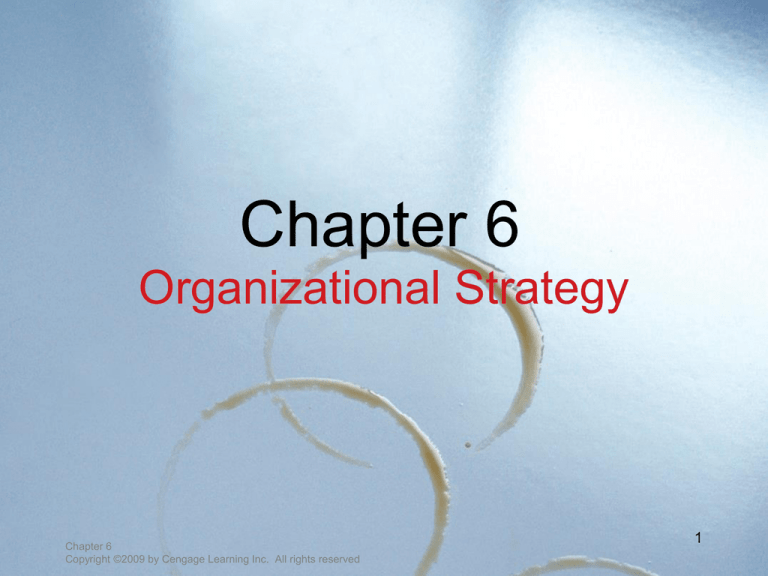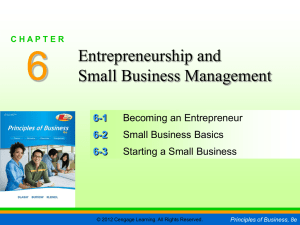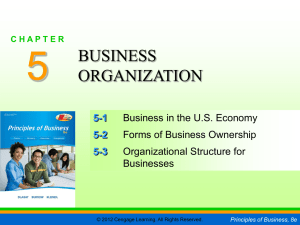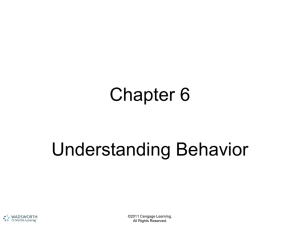
Chapter 6
Organizational Strategy
Chapter 6
Copyright ©2009 by Cengage Learning Inc. All rights reserved
1
Sustainable
Competitive Advantage
Resources
The assets, capabilities, processes,
information, and knowledge that the
organization controls
Competitive
Advantage
Providing greater value for customers
than competitors can
Sustainable
Competitive
Advantage
A competitive advantage that other
companies have tried unsuccessfully
to duplicate
1
Chapter 6
Copyright ©2009 by Cengage Learning Inc. All rights reserved
4
Requirements for
Sustainable Competitive Advantage
Valuable
Resources
Rare
Resources
Sustainable
Competitive
Advantage
Imperfectly
Imitable
Resources
NonSubstitutable
Resources
1
Chapter 6
Copyright ©2009 by Cengage Learning Inc. All rights reserved
Adapted from Exhibit 6.1
5
Strategy-Making Process
Assess need
for
strategic change
Conduct a
Situational
Analysis
Choose
Strategic
Alternatives
2
Chapter 6
Copyright ©2009 by Cengage Learning Inc. All rights reserved
6
Assessing the Need
for Strategic Change
Step 1
Assess need
for strategic change
Avoid Competitive Inertia
a reluctance to change strategies or competitive
practices that have been successful in the past
Look for Strategic Dissonance
2.1
a discrepancy between a company’s intended
strategy and the strategic actions managers take
when implementing that strategy
Chapter 6
Copyright ©2009 by Cengage Learning Inc. All rights reserved
7
Doing the Right Thing
Is Ethics an Overlooked Source of
Competitive Advantage?
Volvo’s reputation for safe cars has been
a source of competitive advantage
Johnson & Johnson is admired for its response
to the Tylenol cyanide contamination incidence
Should ethics be the first source of
competitive advantage? Probably not…
2.1
Start with low costs, good service, or unique product
capabilities. Use ethics as a way to differentiate your
company from the competition.
Chapter 6
Copyright ©2009 by Cengage Learning Inc. All rights reserved
8
Situational Analysis
S
Strengths
Internal
W
Weaknesses
O
Opportunities
External
T
Threats
2.2
Chapter 6
Copyright ©2009 by Cengage Learning Inc. All rights reserved
12
Situational Analysis
I
N
T
E
R
N
A
L
Strengths
•Distinctive
Competence
•Core Capability
Weaknesses
Opportunities
E
X
T
E
R
N
A
L
•Environmental
Scanning
•Strategic Groups
•Shadow-Strategy
Task Force
Threats
2.2
Chapter 6
Copyright ©2009 by Cengage Learning Inc. All rights reserved
Adapted from Exhibit 6.4
13
Strategic Groups
Core Firms
central companies in a strategic group
Secondary Firms
firms that follow related, but somewhat
different, strategies than do core firms
Transient Firms
companies whose strategies change from one
strategic position to another
Shadow-strategy task force
seeks out its own company’s weaknesses
2.2
and determine how other companies could14
Chapter 6
exploit
them
Copyright ©2009
by Cengage Learning
Inc. All rights reserved
Choosing Strategic Alternatives
Risk-Avoiding Strategy
protect an existing
competitive advantage
Risk-Seeking Strategy
extend or create a sustainable
competitive advantage
Strategic Reference Points
2.3
targets used by managers to determine if the
firm has developed the core competencies it
needs to achieve a sustainable competitive
advantage
Chapter 6
Copyright ©2009 by Cengage Learning Inc. All rights reserved
16
Menard’s : Risk Seeking
Chapter 6
Copyright ©2009 by Cengage Learning Inc. All rights reserved
17
Biz Flix: Seabiscuit
What aspects of
strategic planning do
you see in the clip?
Does Pollard suggest
his friend be risk
seeking or risk averse
during the race?
Chapter 6
Copyright ©2009 by Cengage Learning Inc. All rights reserved
Take Two Video
Click
18
Strategic Reference Points
2.3
Adapted from Exhibit 6.6
Chapter 6
Copyright ©2009 by Cengage Learning Inc. All rights reserved
19
Corporate-Level Strategies
Corporate-Level
Strategy
The overall organizational strategy
that addresses the question “What
business(es) are we in or should we
be in?”
3
Chapter 6
Copyright ©2009 by Cengage Learning Inc. All rights reserved
21
Corporate-Level Strategies
PORTFOLIO STRATEGY
Acquisitions,
unrelated diversification,
related diversification,
single businesses
BCG Matrix
Stars
Question marks
Cash cows
Dogs
GRAND STRATEGIES
Growth
Stability
Retrenchment/
recovery
3
Adapted from Exhibit 6.7
Chapter 6
Copyright ©2009 by Cengage Learning Inc. All rights reserved
22
Market Growth
BCG Matrix
3.1
High
Question Marks
Stars
Low
Dogs
Cash Cows
Small
Large
Relative Market Share
Chapter 6
Copyright ©2009 by Cengage Learning Inc. All rights reserved
23
BCG Matrix
3.1
Stars
companies with a large share
of a fast-growing market
Question
Marks
companies with a small share
of a fast-growing market
Cash
Cows
companies with a large share
of a slow-growing market
Dogs
companies with a small share
of a slow-growing market
Chapter 6
Copyright ©2009 by Cengage Learning Inc. All rights reserved
24
BCG Matrix
Market Growth
Company A
High
Question Marks
Low
Dogs
Company H
Stars
Company C
Company B
Company G
Company D
Company E
Cash Cows
Company F
3.1
Small
Large
Relative Market Share
Chapter 6
Copyright ©2009 by Cengage Learning Inc. All rights reserved
Adapted from Exhibit 6.8
25
Diversification and Risk
Risk
High
Relationship Between
Diversification and Risk
Low
3.1
Single
Business
Related
Diversification
Chapter 6
Copyright ©2009 by Cengage Learning Inc. All rights reserved
Unrelated
Diversification
Adapted from Exhibit 6.9
26
Problems with Portfolio Strategy
Unrelated diversification does not reduce risk.
Present performance is used to predict future
performance.
Cash cows fail to aggressively pursue opportunities
and defense themselves from threats.
Being labeled a “cash cow” can hurt employee
morale.
Companies often overpay to acquire stars.
Acquiring firms often treat stars as “conquered foes.”
Chapter 6
Copyright ©2009 by Cengage Learning Inc. All rights reserved
27
Grand Strategies
Growth
Strategy
focuses on increasing profits,
revenues, market share, or number
of places to do business
Stability
Strategy
focuses on improving the way in which
the company sells the same products
or services to the same customers
Retrenchment
Strategy
focuses on turning around very poor
company performance by shrinking
the size or scope of the business
3.2
Chapter 6
Copyright ©2009 by Cengage Learning Inc. All rights reserved
28
Industry-Level Strategies
Five
Industry Forces
Positioning
Strategies
Adaptive
Strategies
Answers the question: How should we
compete in this industry?
4
Chapter 6
Copyright ©2009 by Cengage Learning Inc. All rights reserved
29
Porter’s Five Industry
Forces Easy to start a
Threats of
New
Entrants
How
intense
is the
company in this
industry?
competitive behavior
between companies in
your industry?
Bargaining
Power of
Suppliers
Character
of
Rivalry
Do your suppliers
control you?
4.1
Bargaining
Power of
Buyers
Do your customers
control you?
Threat of
Substitutes
Chapter 6
Copyright ©2009 by Cengage Learning Inc. All rights reserved
Easy to find substitute
products/services?
Adapted from Exhibit 6.12
30
Positioning Strategies
Cost Leadership
Differentiation
Focus Strategy
4.2
Use one of the above strategies for a
specific group of customers in a specific
geographic region or market segment.31
Chapter 6
Copyright ©2009 by Cengage Learning Inc. All rights reserved
Differentiation
Chapter 6
Copyright ©2009 by Cengage Learning Inc. All rights reserved
32
Adaptive Strategies
Defenders
4.3
Prospectors
seek moderate growth
seek fast growth
retain customers
emphasize risk taking
innovation
Analyzers
Reactors
blend of defender &
prospector strategies
use an inconsistent
strategy
imitate other’s
successes
respond to changes
THE END
Chapter 6
Copyright ©2009 by Cengage Learning Inc. All rights reserved
33
Firm-Level Strategies
Basics of
Direct
Competition
Strategic Moves
in
Direct
Competition
Entrepreneurship
and
Intrapreneurship
5
Chapter 6
Copyright ©2009 by Cengage Learning Inc. All rights reserved
34
Firm-Level Strategies
DIRECT
COMPETITION
STRATEGIC
MOVES OF
DIRECT COMP.
ENTREPRENEURIAL
INTRAPRENEURIAL
ORIENTATION
Market commonality
Attack
Autonomy
Resource similarity
Response
Innovativeness
Risk taking
Proactiveness
Competitive
Aggressiveness
5
Chapter 6
Copyright ©2009 by Cengage Learning Inc. All rights reserved
35
Firm-Level Strategies
Market Commonality
Resource Similarity
Attack
Response
Firm A
5
Firm B
Entering market is most forceful attack.
Exiting market is clear defensive signal of retreat.
Entrepreneurship is strategy of entering established
markets
or developing new market.
Adapted from Exhibit 6.13 36
Chapter 6
Copyright ©2009 by Cengage Learning Inc. All rights reserved
Market Commonality
Direct Competition
5.1
McDonald’s
Wendy’s McDonald’s
Burger
King
High
McDonald’s
II
I
III
IV
McDonald’s
Low
Subway
Luby’s Cafeteria
Low
High
Resource Similarity
Chapter 6
Copyright ©2009 by Cengage Learning Inc. All rights reserved
Adapted from Exhibit 6.14
37
Strategic Moves of
Direct Competition
Attack
A competitive move designed to reduce a
rival’s market share or profits.
Response
A competitive countermove, prompted by
a rival’s attack, to defend or improve a
company’s market share or profit.
5.2
Chapter 6
Copyright ©2009 by Cengage Learning Inc. All rights reserved
38
Strategic Moves of
Direct Competition
Types of Responses
1. Match or mirror your competitor’s move.
2. Respond along a different dimension from
your competitor’s move or attack.
5.2
Chapter 6
Copyright ©2009 by Cengage Learning Inc. All rights reserved
39
Strategic Moves of
Direct Competition
Competitor Analysis
Interfirm Rivalry:
Action & Response
Strong Market
Commonality
Less Likelihood
of an Attack
Weak Market
Commonality
Greater Likelihood
of an Attack
Strong Resource
Commonality
Less Likelihood
of a Response
Low Resource
Commonality
Greater Likelihood
of a Response
5.2
Chapter 6
Copyright ©2009 by Cengage Learning Inc. All rights reserved
Adapted from Exhibit 6.15 40
Entrepreneurship and
Intrapreneurship
Entrepreneurship
the process of entering new or established
markets with new goods or services
Intrapreneurship
entrepreneurship within an
existing organization
Entrepreneurial orientation
the set of processes, practices, and decisionmaking activities that lead to new entry
5.3
Chapter 6
Copyright ©2009 by Cengage Learning Inc. All rights reserved
41
Key Dimensions of
Entrepreneurial Orientation
Risk Taking
Autonomy
Innovativeness
Proactiveness
5.3
Competitive
Aggressiveness
Chapter 6
Copyright ©2009 by Cengage Learning Inc. All rights reserved
42
Entrepreneurship
Chapter 6
Copyright ©2009 by Cengage Learning Inc. All rights reserved
43








